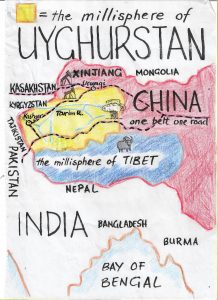Millisphere, abstract noun. A region inhabited by roughly one thousandth of the world population, around seven million people. A lens to examine human geography.
Australia (2018 population 25 million) can be neatly divided into three millispheres: Gold Coast, Tasmania and OZ. Most of Australia’s population hugs the east coast, as do the Great Dividing Range and the Australian Alps.
Designed from scratch and sited near the watershed the capital, Canberra, by some conceptual fluke, sits where Australia’s three millispheres meet.
Gold Coast, to the north, includes Sydney (5.1 million) and Brisbane (2.4 million) and the short rivers flowing east towards the Pacific. Tasmania, to the south, includes Melbourne (4.9 million) and the island of Tasmania (half-a-million) and the watershed east and south from the Australian Alps. The watershed flowing west into the Murray/Darling river system, which is often dry when it discharges into the Great Australian Bight near Adelaide (population 1.3 million), and the rest of Australia all the way to Perth (population 2 million), on the west coast, are needed to form the third millisphere, OZ.
Australia is the world’s 13th largest economy, with the 10th highest per capita income and it attracts New Zealand economic emigrants. By New Zealand standards Australians are a stay-at-home lot. One million Aussies (4%) live outside Australia while around one million Kiwis (20%) live outside New Zealand – half of those live in Australia. Of the NZ population moving to Australia, NZ Maori have proved more inclined to emigrate than their Pakeha (European) fellow citizens. Over the past two years Australia has forcibly deported one thousand New Zealanders (many of them Maori) following the automatic cancellation of their visas if convicted of an offence that could incur more than 12 months in prison.
Australia has made a point of turning away Iraqi, Afghan and other asylum seekers arriving by boat from populous Muslim Indonesia to the north. The 2002 Bali nightclub bombing which killed 94 Australian tourists and the 2004 bombing of the Australian embassy in Jakarta confirmed Australian paranoia. Australia’s “Pacific solution” has been to detain asylum seekers in camps in Manus Island (Papua New Guinea) and Nauru and to try and convince them to go home or somewhere else.
“Why don’t they take the Afghan boat people?” someone in Europe asked me after the “Tampa” incident, “they are used to living in a desert, aren’t they?” The reality is that the Australian interior is so dry as to be virtually uninhabitable and around the coast there is barely enough water for the people already there. Australia has recently cancelled its A$10 million funding to the United Nations for the Palestinians, following Donald Trump’s lead.
 Australia has just experienced the “millennium drought”, the worst drought since European settlement and municipal water supplies were drying up. Irrigation was identified as the main culprit for the ecological catastrophe inflicting the Murray/Darling river system. In 2008 the government established the Murray-Darling Basin Authority (MDBA), attempting to mediate inter-state water rivalries and manage the river in an integrated sustainable manner.
Australia has just experienced the “millennium drought”, the worst drought since European settlement and municipal water supplies were drying up. Irrigation was identified as the main culprit for the ecological catastrophe inflicting the Murray/Darling river system. In 2008 the government established the Murray-Darling Basin Authority (MDBA), attempting to mediate inter-state water rivalries and manage the river in an integrated sustainable manner.
Australia is the world’s fourth highest wine exporting country, much of it from the MDBA (population two million). One third of Australia’s agricultural production comes from the MDBA, but getting the cotton growers of Queensland and New South Wales to give up their irrigation water for the ecological health of the river is a very big ask.
During the “big dry” the coastal cities all initiated expensive desalination schemes. Sydney’s cost A$1.8 billion, Melbourne opened one in 2011 at the cost of A$3.1 billion. Perth, Brisbane and Adelaide all fired up smaller pilot plants to drought-proof their cities.
Down under the red-brown landscape of the virtually uninhabitable interior are Australia’s mines. “The lucky country” is the world’s largest coal exporter, it is one of the world’s biggest uranium exporters, and it will soon be the world’s largest gas explorer. Australia also has the world’s highest power prices and some of the highest carbon emission rates. Australia with 0.3% of the global population produces 1.3% of total global emissions.
By signing the Paris accord Australia has committed to reducing its own CO2 emissions. Australia’s environmental movement is largely an urban phenomenon but ironically Australia’s economy, and its cities, are underpinned by mining. Australia introduced a carbon tax in 2012, but scrapped it in 2014.



